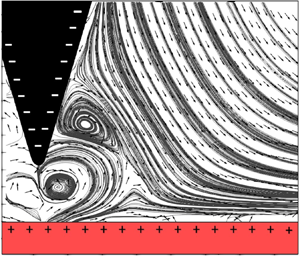Article contents
Electrically driven toroidal Moffatt vortices: experimental observations
Published online by Cambridge University Press: 05 August 2020
Abstract

In this work, we report the first experimental observation of electrically driven Moffatt vortices between conical surfaces. The flow field is captured using a synchronized multi-camera particle image velocimetry experiment. The results reveal a flow bifurcation resembling Moffatt vortices in canola oil with −12 kV applied to an axisymmetric point-to-plane electrode set-up. The formation of such vortices was predicted theoretically; however, to the best of our knowledge, experimental observations were not reported earlier. The experimental results of the present work are shown to be in agreement with the available theoretical predictions. In addition, the observed vortices are slightly transient, suggesting the next bifurcation reminiscent of the Taylor vortices in the Taylor–Couette flow.
Information
- Type
- JFM Papers
- Information
- Copyright
- © The Author(s), 2020. Published by Cambridge University Press
References
- 4
- Cited by

